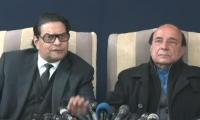Pakistan has struggled with chronic economic problems and a balance of payments crisis since independence. Its history of such crises and dependence on financial support of the International Monetary Fund (IMF) to meet its foreign exchange shortages goes back to 1958, when the first agreement was signed with the IMF.
The current bailout programme under discussion for revival is our 23rd, which means the country has been going to the IMF every three years, making Pakistan the most frequent customer of the Fund. However, despite such recurring programmes, Pakistan’s fiscal and external account deficits have gone from bad to worse.
The basic problem of excessive reliance on imports, low foreign currency earnings from exports and remittances (current account deficit), arose primarily because of flawed economic policies, too much bureaucracy, multiple governments, over regulation and excessive taxation – which created a pernicious environment for development entrepreneurship and innovation necessary for a productive economy.
While the blame for Pakistan's economic mess lies primarily on its own leaders, there are questions to be asked about the role of the IMF and other IFIs (the World Bank and the Asian Development Bank). Why has over 60 years of engagement with these institutions not helped in improving our macro-economic framework and why could meaningful reforms in governance and public financial management not be implemented to avoid the country’s recurring insolvency?
The current economic situation of Pakistan is grim, with foreign exchange reserves plummeting to $3 billion, equal to the Saudi deposit that was given – only to be held as part of the reserves. This means zero reserves. Three major rating agencies have downgraded Pakistan’s risk rating to the status of junk bonds. As a consequence, the country has no capacity to raise debt from the international market. For the last six months, there has been an embargo on imports – only exporters are allowed to import from proceeds they bring.
Despite the fact that the country urgently required vital support from the IMF, the government chose to blatantly disregard the terms of the fund program, resulting in a waste of five months, depletion of reserves exceeding $5 billion, and significant harm to the country's reputation and export market. The haphazard implementation of measures such as keeping the rupee overvalued (with a Rs40 difference between interbank and open market of dollar) and severe restrictions on dollar payments made it impossible to obtain LCs even for essential imports. Over tens of thousands of containers are currently stranded at ports, numerous factories across the country have been forced to shut down, inflation has skyrocketed to a staggering 27 per cent, and the economy is rife with uncertainty across all sectors.
Unsurprisingly, the government had to yield to all the conditions of the Fund, but only after an inordinate delay in the commencement of the Ninth Review, and five months of mindless mishandling of the economy that has created a mess that will be hard to repair even by the revival of the IMF programme.
After protracted 10-day deliberations with Ministry of Finance officials, the IMF mission departed on February 10, without a clear announcement regarding whether and when the programme is likely to be revived. Although the government has started implementing prior actions through a mini-budget that entails levy of additional taxes of Rs170 billion plus a steep increase in gas and electricity tariffs, significant ambiguity still remains about whether it will be able to mobilize nearly $8 billion to $10 billion from friendly countries to meet the funding gap. Thus, doubts about resumption of the programme and the risk of default have not subsided.
While the revival of the IMF agreement, which still seems not a done deal, will bring some respite through some influx of dollars from the Fund and IFIs, it will only provide a breather for three months, as the programme ends in June 23.
According to former deputy governor of the State Bank of Pakistan Mr Murtaza Syed, the country requires a whopping $35 billion annually for the next five years – $25 billion just for debt repayment and $10 billion for current account deficits. And even if we somehow manage to reduce the latter to $5 billion, raising $30 billion a year is a daunting sum to mobilize for a country that is under huge debt burden with low confidence of investors and lenders. Clearly, if these figures are right, the revival of the current IMF programme is unlikely to restore confidence that is necessary to normalize the country’s trade and investment transactions with local and international investors, buyers and sellers.
So, what's next? Will Pakistan be forever bound to IMF programmes and forever be relying on aid from friendly nations? How long can lenders and friendly countries support Pakistan to meet its perennial foreign exchange shortages? Can the people indefinitely tolerate over 30 per cent inflation and a stagnant economy?
The harsh reality is that the country has reached a stage, where the ‘business as usual’ that has continued for decades is no longer possible. In my humble judgement, there are two possible options that Pakistan and its key lenders (IMF and IFIs) need to seriously consider, that must not only entail addressing its funding requirements in the medium term, but also implement structural reforms necessary to restore confidence on the economy.
One, a special programme jointly designed by the IMF and IFIs that provides sufficient funding (say three times the current programme) for the next three years to sustain estimated current account deficits and debt repayments during such period; or two, initiate a process of major debt restructuring (rescheduling and reprofiling) to stagger the repayments of debt significantly.
Logically speaking, either of the above options is unlikely to provide tangible results, both for Pakistan as well as the lenders, unless they also include a comprehensive and credible plan (what I describe as ‘creative destruction’ – to be covered in my next article). The plan should entail the overhaul and reinvention of the country's governance, management and socio-economic policies that can put the country on track to generate sufficient cash flows to be able to repay its enhanced/rescheduled/re-profiled debt along with putting the country on the path to sustainable economic growth.
Pakistan has had more than its share of IMF programmes. We must now strive to have one comprehensive programme that can provide stability, improve its human capital and entrepreneurship that are essential for sustainable growth. And which should be the last of such programmes.
The writer is a former managing partner of a leading professional services firm and has done extensive work on governance in the public and private sectors.
He tweets @Asad_Ashah
Many people believe that in future, AI will play an even more significant role in their lives
In April 2024, three Chinese and one Belarusian company were sanctioned for exporting missile-enabling technology to...
Pakistan has second highest neonatal mortality in world; in education sector, country's 26 million kids are out of...
Key actors in global power politics are US, China, Russia, European Union, and emerging powers such as India and Brazil
Maulana Fazl manages to bring together factions that historically stand opposed
NASA says August 2024 set new monthly temperature record, capping Earth’s hottest summer since 1880







